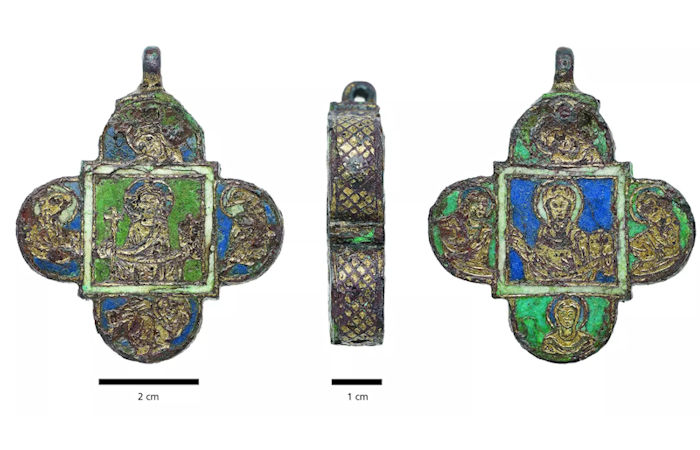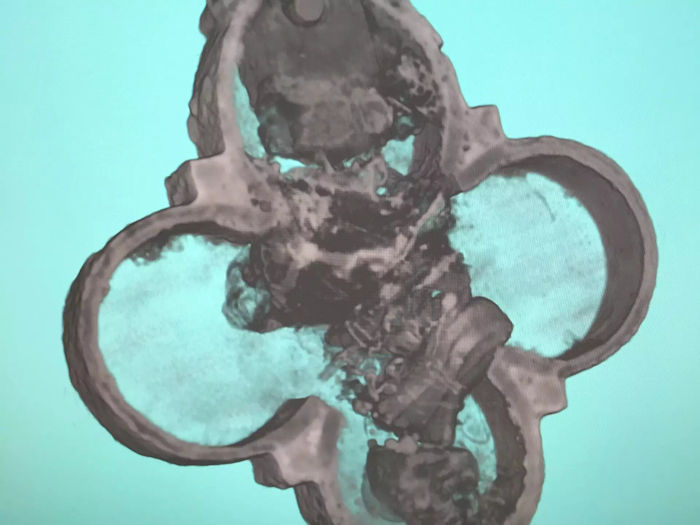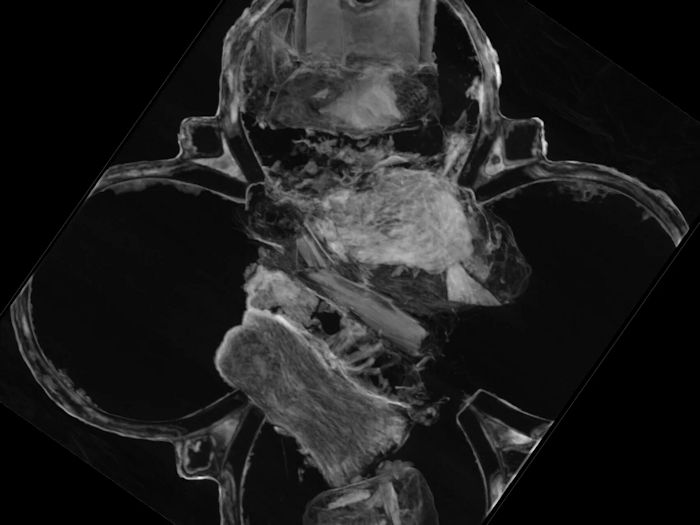Jan Bartek – AncientPages.com – A research team has solved the mystery of a gold-plated pendant found in a Medieval refuse pit in the Old City section of Mainz, Germany. Using non-destructive neutron tomography, the scientists determined extremely small bone fragments were hidden inside the pendant.
The interdisciplinary research team led by the Leibniz-Zentrum für Archäologie (LEIZA) conducted the study.

The restored reliquary. It is decorated with images of Jesus and Mary. Credit: Technical University Munich
Five individual packets made of silk and linen were discovered during the evaluation of the tomographies and the Prompt Gamma Activation Analysis (PGAA) with neutrons. Each of the five packets contained bone fragments. “The non-destructive investigation with neutrons was particularly useful since we couldn’t simply open the pendant and look inside. Centuries of corrosion have heavily damaged the object as a whole, especially the lock mechanism; opening the pendant would have meant destroying it beyond all hope of repair,” says Matthias Heinzel, who works as a restorer at LEIZA.
During restoration, he discovered a cord fragment in the pendant’s attachment loop, which turned out to be silk on closer examination.

Neutron tomography shows the interior of the relic pendant. Credit: Technical University Munich
“This is the first proof that this kind of pendant may possibly have been worn around the neck on a silk cord. The neutron tomography at TUM meant we could additionally measure the thread size and the string separations of the textiles inside the pendant,” Heinzel adds.
Neutron analysis makes organic substances visible
In 500 hours of work, Heinzel meticulously removed corrosion deposits from the find. Initial investigations showed that the approximately 6 cm high, 6 cm wide and 1 cm thick pendant was presumably a storage container for religious relics. Since the organic content of the pendant was not visible in the first X-ray images, investigation was continued using neutrons from the FRM II: Dr. Burkhard Schillinger of the Technical University of Munich (TUM) conducted the neutron tomography using the ANTARES instrument; this rendered the individual textile packages inside containing the bone fragments. The researchers determined individual elements of the sample by triggering them to emit characteristic gamma radiation at the PGAA using neutrons.
“We can’t say whether or not these bone splinters are from a saint and, if so, which one. Usually relic packages contain a strip of parchment indicating the name of the saint.
In this case, however, we unfortunately can’t see one. As an archaeological research insтιтute of the Leibniz ᴀssociation, we consider it our duty to preserve the object in its historical authenticity as completely as possible for future generations and to leverage the modern opportunities of non-destructive investigation at the Technical University of Munich,” says Heinzel.

Five relic packages can be seen inside. Credit: Technical University Munich
Only three other relic containers of this type referred to as phylacteries, are known to date. The term phylactery is derived from the Greek term for safekeeping or protection. Their owners wore them on their bodies and usually hung them around the neck. The exterior of the gold-plated pendant made of copper shows pictures of Jesus, the four Evangelists, Maria, and four female saints in enamel.
The researchers dated the pendant to the late 12th century and attribute it to a workshop in Hildesheim, Lower Saxony, in Germany. The find is in possession of the General Directorate for Cultural Inheritance (Generaldirektion kulturelles Erbe or GDKE) at the State Archeological Directorate of Mainz (Direktion Landesarchäologie Mainz) and can be viewed for the time being in the medieval exhibition AUREA MAGONTIA—Mainz in the Middle Ages at the Mainz State Museum.
The complete study is available here
Written by Jan Bartek – AncientPages.com Staff Writer





